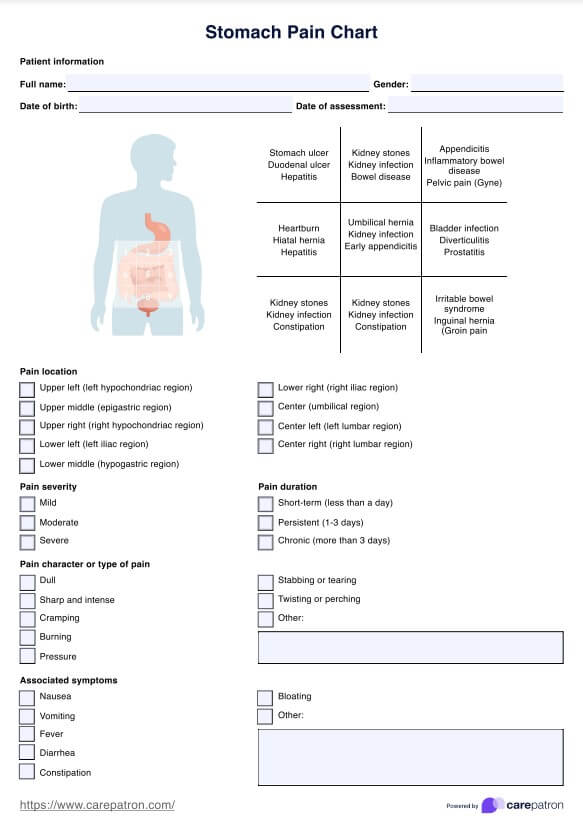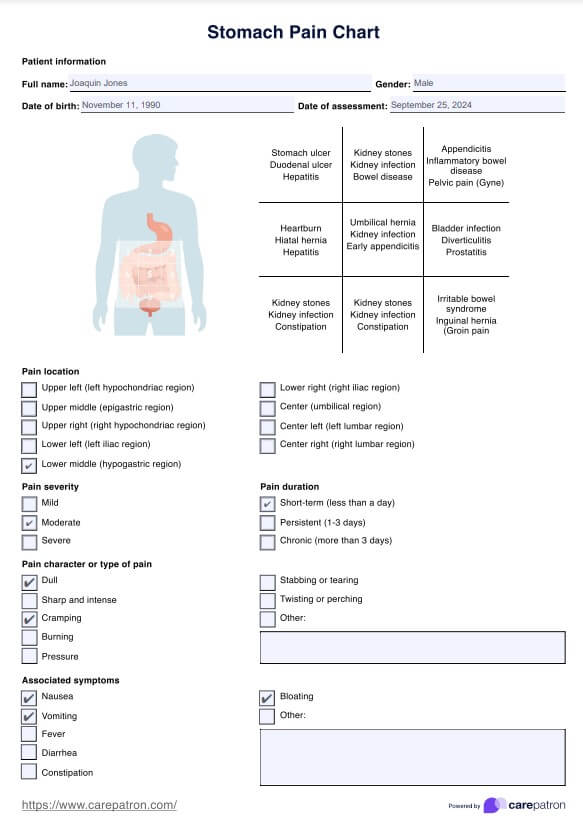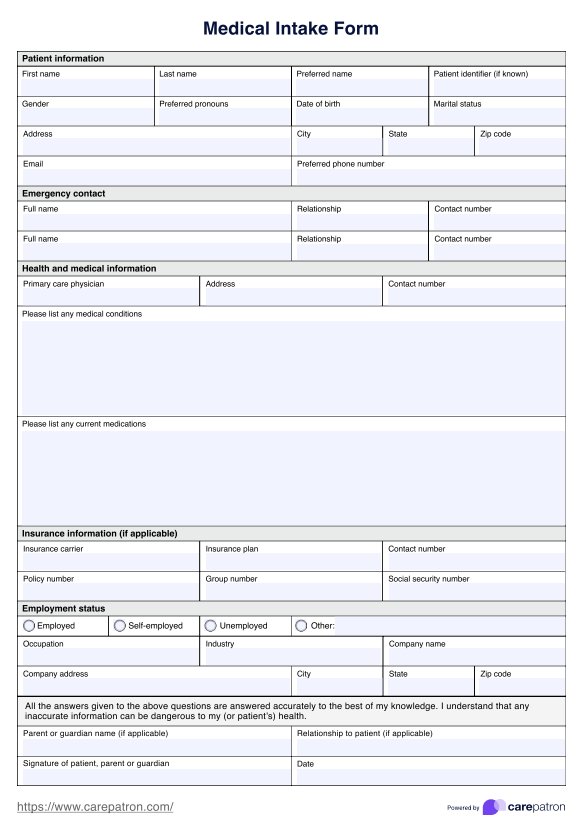Stomach Pain Chart
Stomach Pain Chart: Detailed tool for documenting abdominal pain, including location, intensity, symptoms, causes, and medical assessments.


How to describe abdominal pain?
Describing abdominal pain accurately is crucial for diagnosis and treatment. Here are key ways to characterize abdominal pain:
Location
The location of abdominal pain can give important clues about its cause. The abdomen is divided into four quadrants: upper right, upper left, lower right, and lower left. Pain in the upper part could indicate problems with organs such as the stomach, liver, or pancreas, while pain in the lower could indicate issues with the intestines or reproductive organs.
Type of pain
The type of pain can also provide valuable information. Abdominal pain can be classified as either visceral or somatic. A problem with an internal organ causes visceral pain and is often described as dull, achy, or cramp-like. On the other hand, somatic pain involves irritation to the body's abdominal wall and is usually described as sharp, stabbing, or burning.
Severity
The severity of abdominal pain can range from mild discomfort to intense and debilitating pain. This can help doctors determine the urgency of treatment needed.
Duration
How long the pain has been present is another important factor in describing abdominal pain. Acute abdominal pain starts suddenly and lasts for a short period, while chronic pain persists for weeks or even months.
Aggravating and alleviating factors
Certain activities or positions can worsen abdominal pain, while others may provide relief. Noting these aggravating and alleviating factors can help identify the cause of the pain.
Associated symptoms
Abdominal pain is often accompanied by other symptoms such as nausea, vomiting, diarrhea, constipation, fever, or weight loss. These associated symptoms can provide further clues as to the underlying cause.
Stomach Pain Chart Template
Stomach Pain Chart Example
How to use our Stomach Pain Chart template?
A stomach pain chart helps identify the cause of abdominal discomfort based on the location, intensity, and characteristics of the pain. So, after you download a copy, here's a step-by-step guide on how to use one effectively:
Step 1: Locate the pain
Ask your patient where they feel the pain and mark the region, if it's centralized, or regions where they feel it on the map of stomach pain.
Step 2: Assess the pain type, severity, and duration
Have your patient describe the pain, rate it from mild to severe, and mention how long they have been in pain. Note the information you gather on the template by ticking the appropriate boxes on the belly pain chart.
Step 3: Note down other relevant information
To properly diagnose the cause of the stomach pain, it's best to gather additional relevant information, such as triggers and accompanying symptoms like nausea, vomiting, belly pain, and a fever. Keep note of these by ticking the appropriate boxes or writing them down in the provided note section.
Step 4: Store securely
After diagnosis, securely store the chart. This will come in handy especially for recurring pain to track any patterns over time to identify any triggers or trends.
What are the most common causes of abdominal pain by location?
The abdomen can be divided into different regions, and the location of pain can often provide clues about its underlying cause. Here are the most common causes of abdominal pain by location:
- Upper right quadrant (URQ): The URQ contains the liver, gallbladder, and part of the small intestine. Common causes of abdominal pain in this area include gallstones, liver disease, and appendicitis.
- Upper left quadrant (ULQ): The ULQ is home to the stomach, spleen, and part of the large intestine. Pain in this area can be caused by gastritis, pancreatitis, or kidney stones.
- Lower right quadrant (LRQ): The LRQ contains the appendix and part of the large intestine. Appendicitis is a common cause of abdominal pain in this area, but other possible causes include Crohn's disease and ovarian cysts.
- Lower left quadrant (LLQ): The LLQ houses the descending colon and part of the small intestine. Common causes of abdominal pain in this area include diverticulitis, constipation, and pelvic inflammatory disease.
- Midline: Pain in the center of the abdomen can be caused by various conditions, including indigestion, intestinal obstruction, and kidney stones.
- Generalized: Generalized abdominal pain can be a symptom of a wide range of conditions, such as food poisoning, gastroenteritis, and irritable bowel syndrome.
While using an abdominal location pain chart can provide important information about its cause, it is not always straightforward. Some conditions won't only have upper abdominal pain or lower abdominal pain alone but rather may present in multiple areas or refer to different locations.
How do you diagnose and treat abdominal pain?
Diagnosing and treating abdominal pain, especially when considering specific areas like the upper and lower quadrants, requires a thorough approach due to the variety of potential underlying causes:
Diagnosing abdominal pain
These are the steps to diagnose abdominal pain:
- Medical history and pain assessment: Initially, the healthcare provider will gather a detailed medical history and assess the characteristics of the abdominal pain. This includes understanding the specific location using an abdomen pain map (upper quadrant abdominal pain, left upper quadrant pain, right upper quadrant pain, left lower quadrant pain, right lower quadrant pain) and the nature of the pain (sharp, dull, cramping).
- Physical examination: A comprehensive abdominal exam is conducted to identify any tenderness, swelling, or other abnormalities. This may involve palpating different areas of the abdomen such as the abdominal wall to pinpoint the location of the discomfort and to understand its relation to different organs. You can use this abdominal pain chart template to help outline actionable strategies for pain improvement.
- Diagnostic testing: Depending on the initial assessment, various diagnostic tests such as blood tests, urinalysis, ultrasound, CT scans, or MRIs might be ordered. These tests help identify issues like kidney stones in the lower quadrants or gastrointestinal and liver disease in the upper quadrants.
- Consideration of specific conditions: The differential diagnosis is crucial, especially when symptoms are ambiguous. Conditions like inflammatory bowel disease, gastrointestinal disorders, liver disease, or kidney stones can present with similar symptoms but require different treatments. A systematic approach to differential diagnosis is key.
Treating abdominal pain
Here are some treatment options for stomach pain:
- Symptomatic relief: Treatments may involve pain relievers, antacids, or heat therapy to alleviate general abdominal discomfort.
- Follow-up and monitoring: Consistent follow-up is crucial, particularly for chronic conditions like inflammatory bowel disease or recurrent kidney stones.
- Lifestyle modifications: Guidance on diet, exercise, and stress management may form an integral part of the treatment plan, particularly for conditions affecting the upper abdomen.
- Prescription medication: In some cases, prescription medications may be necessary to manage underlying conditions or symptoms. These may include antibiotics for infections, antispasmodics for irritable bowel syndrome, or corticosteroids for inflammatory conditions.
- Surgery: Depending on the underlying cause of abdominal pain, surgery may be necessary to correct structural abnormalities or remove diseased tissue.
Commonly asked questions
Pain in the right upper quadrant can be caused by conditions affecting the liver, gallbladder, or right kidney. Common issues include gallstones, liver disease, and kidney infections. Understanding the specific nature and duration of pain is crucial in differential diagnosis.
Mild abdominal pain is often due to benign issues like indigestion or minor muscle strain. However, if the pain persists and is accompanied by symptoms like persistent nausea, fever, or changes in bowel movements, or if it intensifies rapidly, it could indicate more serious conditions like peptic ulcer disease, appendicitis, or kidney stones. A physical exam and possibly further diagnostic tests are recommended in such cases.
Generalized abdominal pain, which is felt over more than half of the abdomen, can be a sign of indigestion, a viral infection, gas, or even a life-threatening condition like acute abdomen, mesenteric ischemia, or small bowel obstruction. The presence of additional symptoms and a thorough clinical evaluation are necessary to narrow down the cause.















































































































